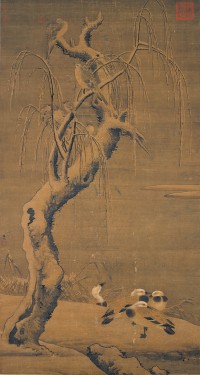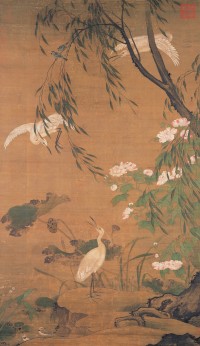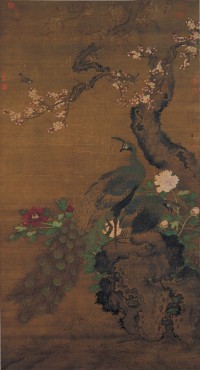|
Introduction
Lü Ji (style name Tingzhen, sobriquet Leyu), a native of Ningbo in Zhejiang, was a famous court painter of the middle Ming dynasty. Many details of his life are still unknown, so only through records of related individuals and his promotion at court can we infer that he was probably born in 1429 under the Xuande Emperor and died around 1505 under the Hongzhi Emperor. Lü Ji entered the court late under the Chenghua Emperor (r. 1465-1487) and became highly regarded by the Hongzhi Emperor (r. 1488-1505), serving in the Renzhi Palace and rising to the sinecure post for painters of Commander of the Imperial Bodyguard. At one time when he fell ill, the emperor even continued sending his regards, about which Lü Ji said of himself, "Such great benefaction is difficult to bear." The poet Hang Huai (1462-1538) in a verse entitled "Inscribed on a Painting of 'Apricot Blossoms'" from his Shuangxi Anthology included the line, "In recent times the paintings of Lü Ji are the best."
According to historical records, Lü Ji first studied the painting style of Bian Wenjin (ca. 1356-ca. 1428), an important early Ming court painter of bird-and-flower subjects. Lü also once had the opportunity to view and copy famous paintings of the Tang and Song dynasties at the residence of the Imperial Physiognomist, Yuan Zhongche (1376-1458), who hailed from the same hometown. At court Lü Ji further learned from the famous painter Lin Liang (ca. 1424-after 1500), finally developing a style of his own combining "fine-line" and "sketching-idea" manners as well as splendor and naturalness. Lü Ji excelled at rendering emotive scenes, using mostly centered brushwork rounded and upright with force, his coloring bright and beautiful but not lacking in warmth and solidity.
During his service at court, Lü Ji was often summoned to do paintings, and to meet the large numbers of works required by the court, he might have formed a studio with assistants to help complete these imperial commissions. As a bird-and-flower painter of the court greatly admired by the emperor, his works naturally became models for study, not only influencing bird-and-flower painting of the Ming and Qing dynasties, but even that from as far away as Japan. Among the surviving works to Lü Ji's name, some are collaborative efforts done with other court painters, many are by other artists who appropriated his name, while others are spurious imitations.
The imitations of Lü Ji's works are often on the subject of wild geese and ducks or egrets paired with hibiscus, willow trees, or reeds. Sometimes their style is close to the "fine-line" colorful works of Bian Wenjin, while others are more closely associated with the "sketching-idea" painting in monochrome ink by Lin Liang, revealing the atmosphere of clear beauty or hazy mists often seen in Lü Ji's works. This exhibition not only includes representative examples of Lü Ji's bird-and-flower painting but also several imitations that demonstrate the art and influence of his style.
Selections

|
Snowy Landscape and Birds
Lü Ji (ca. 1429-ca. 1505), Ming dynasty
Hanging scroll, ink and colors on silk, 169.6 x 90.5 cm
In this desolate scene after a snowfall, both river and sky appear as dark as ink. Several wild ducks are huddled against the cold, with a few already asleep. Freezing sparrows and cold spotted doves perch on the branches of the drooping willow tree above. Lü Ji has here fully grasped the reality of atmosphere in this scenery, allowing the viewer to feel the cold of a winter's day. The use of brush and ink reveals Lü Ji's uncontrived and natural style. With even greater abbreviation and succinctness, it differs from his other works by adding another layer of archaic simplicity.
|
| |
|

|
Autumn Shoals and Waterfowl
Lü Ji (ca. 1429-ca. 1505), Ming dynasty
Hanging scroll, ink and colors on silk, 177.2 x 107.3 cm
On a hazy and misty autumn evening, a partial bright moon appears suspended in the skies above. Four bean geese rest on a bank with hibiscus and reeds; three have already fallen asleep as another cries out at the moon. The brushwork in painting the birds and flowers in this work is fine but not stiff, while the rendering of the slope is sketchy yet complete. Not only does this work portray geese resting at night, it also shows the habit of one of the geese standing guard over the others. The painting likewise conveys the coolness of an autumn evening while serving as a means for the artist to lodge the various emotions of a certain time and scene. In terms of technique, this work thus demonstrates Lü Ji's ability to fuse fine and sketchy manners, being a representative example of his grasping both mood and atmosphere.
|
| |
|

|
Autumnal Egrets and Hibiscus
Lü Ji (ca. 1429-ca. 1505), Ming dynasty
Hanging scroll, ink and colors on silk, 192.6 x 111.9 cm
Pink hibiscuses in full bloom on an autumn day appear on the bank of a lily pond as a willow sways in the breeze. With the white egrets, the scene expresses a radiantly beautiful and colorful autumn. In terms of composition, a large waterfowl (white egret) stands on the foreground slope, while the main tree (willow) extends diagonally into the scenery. Perched in the tree are smaller birds (tits), thereby completing a compositional format frequently seen in Lü Ji's paintings. The bird-and-flower motifs in this work are all done with brushwork of even and fluid lines without any stiffness. The brushwork in the tree and rock motifs rises and falls with variation, having both interruption and continuity. The hues are bright and beautifully straightforward, making this a representative example of Lü Ji’s sumptuous court style.
|
| |
|

|
Apricot Blossoms and Peacocks
Lü Ji (ca. 1429-ca. 1505), Ming dynasty
Hanging scroll, ink and colors on silk, 203.4 x 110.6 cm
In China, the peony is associated with wealth and the peacock with splendor. One of the Chinese characters in "peacock" is also a homonym for "noble rank," so this bird symbolizes the rank and position of a high official. Therefore, all elements conform to the atmosphere at court while suggesting scenery from an imperial garden. The brushwork throughout the painting is steady and fine, and the application of blue-and-green colors with lead-white is not temperamental, giving the work a solemn and quiet feeling very much in the manner of Lü Ji. Despite the repetitiveness of the texturing in the tree and rocks along with the patterned sparrows, it could still be a work that Lü Ji had completed with assistants at his studio and thereby retaining the original appearance of his style.
|
| |
|

|
Egrets in Flight
Lü Ji (ca. 1429-ca. 1505), Ming dynasty
Folding fan mounted as an album leaf, ink and colors on paper, 15.7 x 49.1 cm
The seal and signature do not accord with the style of this painting, the brushwork derived from the manner of Lü Ji and tending to have a straightforward quality but nonetheless bearing his simple yet hoary manner. The forms of the white egrets derive from those in "Autumnal Egrets and Hibiscus," the one in the middle being especially similar. The reeds and the rocky slopes are also close to those of "Autumn Shoals and Waterfowl," expressing Lü Ji's misty river scenery and making this an imitation in his style.
|
Text and images are provided by National Palace Museum
|

















